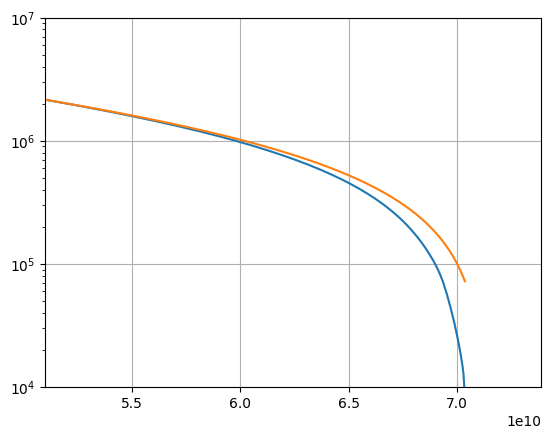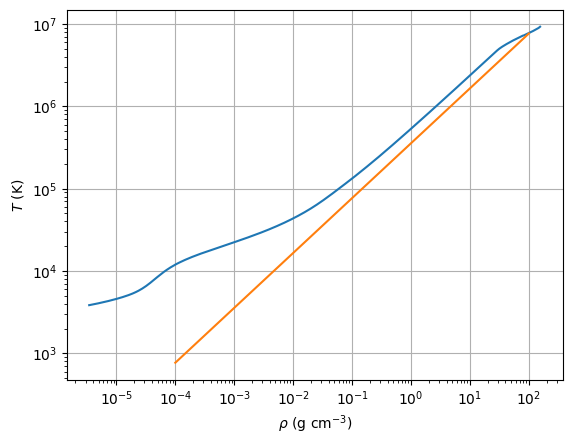Homework #7 MESA models#
import numpy as np
import matplotlib.pyplot as plt
We’ll make some a class to store the data from the model files.
class Profile:
def __init__(self, pfile):
p = np.loadtxt(pfile)
self.r = p[:,0]
self.m = p[:,1]
self.rho = p[:,2]
self.T = p[:,3]
self.P = p[:,4]
self.mu = p[:,5]
self.mu_e = p[:,6]
self.L = p[:,7]
self.X = p[:,8]
self.Y = p[:,9]
self.grad_a = p[:,10]
self.grad_T = p[:,11]
self.q = p[:,12]
# the age is specified on the first line
with open(pfile) as pf:
line = pf.readline()
self.age = line.split("=")[-1].split()[0]
Fundamental constants
# CGS constants
k_B = 1.38e-16
m_u = 1.66e-24
m_e = 9.11e-28
c = 3.e10
h = 6.63e-27
a = 5.67e-15
1. the solar convection zone#
In our homework, we found the convective zone temperature structure is approximately:
Here we’ll compare this to the MESA model for the \(1~M_\odot\) star.
# constants in CGS
m_u = 1.66e-24
G = 6.68e-8
k = 1.38e-16
M_sun = 2.e33
R_sun = 7.e10
First we read in the data
p = Profile("M1.0_profile_H_simple.out")
I’ll find the radius as the first zone (from the center) where the adiabatic excess, \(\nabla - \nabla_\mathrm{ad}\) gets close to 0
idx = np.where(np.abs(p.grad_T - p.grad_a) <= 1.e-3)[0][0]
and we can get the temperature and radius there
T_base = p.T[idx]
R_base = p.r[idx] * R_sun
Here’s our analytic function to plot
def T(r):
gamma = 5./3.
mu = 0.6
return T_base - (1.0 - 1.0 / gamma) * mu * m_u * G * M_sun / k * (1/R_base - 1/r)
and now we can plot the data and the analytic comparison
fig, ax = plt.subplots()
ax.plot(p.r * R_sun, p.T)
ax.plot(p.r * R_sun, T(p.r * R_sun))
ax.set_xlim(left=R_base)
ax.set_ylim(1.e4, 1.e7)
ax.set_yscale("log")
ax.grid()

Notice that the temperature structure compares quite well until we reach the surface of the star.
2. fully-convective polytrope#
We want to compare a fully-convective polytrope to our MESA model for the \(0.3~M_\odot\) star.
We know that:
so we can find that
and for our star, \(\gamma_a = 5/3\).
We’ll take the value of \(K\) we found in homework 5.
p = Profile("M0.3_profile_H_simple.out")
K = 3.4e13
gamma_a = 5./3.
We’ll take \(\mu\) as the value in the center of our model
mu = p.mu[0]
fig, ax = plt.subplots()
ax.loglog(p.rho, p.T)
rho = np.logspace(-4, 2, 100)
T_poly = K * rho**(gamma_a - 1) * mu * m_u / k_B
ax.loglog(rho, T_poly)
ax.set_xlabel(r"$\rho~ \mathrm{(g~cm^{-3})}$")
ax.set_ylabel(r"$T~\mathrm{(K)}$")
ax.grid()

We see that for much of the star (until we near the surface) the trend of the polytrope model is very close to the trend from the MESA star.

